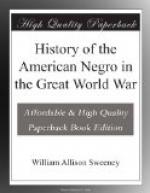On the anniversary of Britain’s entry into the war, August 4, Field Marshall Haig, commander-in-chief of the British forces issued a special order of the day, the opening paragraph of which was:
“The conclusion
of the fourth year of the war marks the passing of
the period of crisis.
We can now with added confidence, look
forward to the future.”
On August 4, General Pershing reported:
“The full fruits of victory in the counter offensive begun so gloriously by Franco-American troops on July 18, were reaped today, when the enemy who met his second great defeat on the Marne, was driven in confusion beyond the line of the Vesle. The enemy, in spite of suffering the severest losses, has proved incapable of stemming the onslaught of our troops, fighting for liberty side by side with French, British and Italian veterans. In the course of the operations, 8,400 prisoners and 133 guns have been captured by our men alone. Our troops have taken Fismes by assault and hold the south bank of the Vesle in this section.”
On August 8, the British and French launched an offensive in Picardy, pressed forward about seven miles on a front of 20 miles, astride the river Somme and captured several towns and 10,000 prisoners. It was in this engagement that the hard fighting at Chipilly Ridge occurred, in which the Americans so ably assisted, notably former National Guardsmen from Chicago and vicinity. Montdidier was taken by the French August 10. The British also continued to advance and by the 11th the Allies had captured 36,000 prisoners and more than 500 guns. A French attack August 19-20 on the Oise-Aisne front, netted 8,000 prisoners and liberated many towns. On the 21st Lassigny was taken by the French. This was the cornerstone of the German position south of the Avre river. On August 29 the Americans won the important battle of Guvigny. By September 2 the Germans were retreating on a front of 130 miles, from Ypres south to Noyon. By the 9th the Germans had been driven back to the original Hindenburg line, where their resistance began to strengthen.
On September 12 the American army, led by General Pershing, won a great battle in the attack on and wiping out of the famous St. Mihiel salient. This victory forced the enemy back upon the Wotan-Hindenburg line, with the French paralleling him from Verdun to the Moselle. Pershing’s forces continued fighting steadily, wearing out the Germans by steady pressure. On September 26 the Americans began another offensive along a front of 20 miles from the Meuse river westward through the Argonne forest. This developed into one of the bloodiest battles of the war for the Americans. On September 29 American and British troops smashed through the Hindenburg line at its strongest point between Cambrai and St. Quentin. British troops entered the suburbs of Cambrai and outflanked St. Quentin. Twenty-two thousand prisoners and more than 300 guns were captured. Meanwhile the Belgians tore a great hole in the German line, ten miles from the North sea, running from Dixmude southward.




